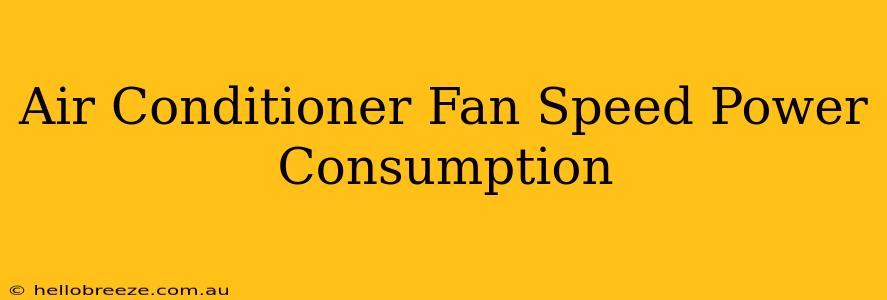Choosing the right fan speed on your air conditioner can significantly impact your energy bills. Understanding the relationship between fan speed and power consumption is key to maximizing efficiency and minimizing costs. This guide will break down how fan speed affects your AC's energy use and offer tips for saving energy.
How Air Conditioner Fan Speed Affects Power Consumption
Your air conditioner's fan speed directly influences its power consumption. The higher the fan speed, the more electricity it uses. This is because a faster fan requires more energy to operate. Let's look at the different speeds:
Low Fan Speed:
- Power Consumption: Lowest power consumption. The compressor runs less frequently because the system needs less work to maintain the desired temperature.
- Cooling Effect: Gentle and gradual cooling. Ideal for mildly warm days or when you prefer a more subtle breeze.
- Best for: Maintaining a comfortable temperature without rapid cooling, saving energy.
Medium Fan Speed:
- Power Consumption: Moderate power consumption. A balance between cooling speed and energy efficiency.
- Cooling Effect: A good balance between speed and energy usage. This setting works well for most situations.
- Best for: Average weather conditions and situations where you need efficient cooling without extremely rapid temperature drops.
High Fan Speed:
- Power Consumption: Highest power consumption. The compressor runs more frequently and for longer durations to meet the demand for faster cooling.
- Cooling Effect: Rapid cooling. Best for quickly cooling a room on a very hot day.
- Best for: Quickly cooling a room when needed, but remember it consumes the most energy.
Energy Saving Tips Related to Air Conditioner Fan Speed
- Start with a lower fan speed: Begin with a lower fan speed and gradually increase it if needed. This allows for gradual cooling and reduces the overall energy used.
- Utilize the "Auto" mode (if available): Many modern AC units have an "Auto" mode that automatically adjusts the fan speed based on the room's temperature. This is often the most energy-efficient option.
- Programmable Thermostats: Using a programmable thermostat allows you to schedule temperature settings, optimizing your AC's usage and minimizing power consumption.
- Regular Maintenance: Ensure your AC unit is properly maintained. Dirty filters restrict airflow, forcing the system to work harder and consume more energy. Clean or replace your filters regularly.
- Other Energy Saving Measures: Consider other energy-saving measures alongside adjusting fan speed, such as using window shades or blinds to reduce solar heat gain and sealing any air leaks in your home.
Understanding Your Air Conditioner's Specifications
Consult your air conditioner's manual for specific information regarding energy consumption at different fan speeds. The manual should provide details on power ratings and energy efficiency ratings.
Conclusion: Finding the Sweet Spot
Finding the optimal fan speed involves balancing comfort with energy efficiency. While high fan speed provides quick cooling, it comes at the cost of increased energy consumption. Experiment with different speeds and settings to find the balance that suits your needs and budget, utilizing energy-saving strategies wherever possible. Remember, small changes can make a big difference in your energy bills and your environmental impact.

